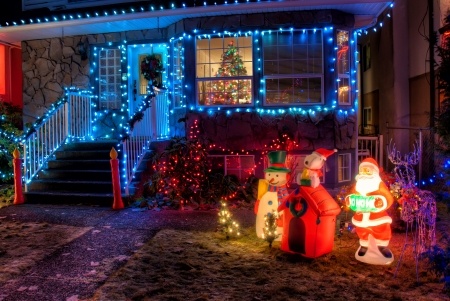Decorate Safely This Holiday Season
December 22, 2015 | Category: Defective Products | ShareAll across the United States families are getting out the twinkle lights, ornaments and other decorations in preparation for the holiday season. Holiday decorating is all about adding some fun, sparkle and warmth to this very special season, it is important to remember that, if not used carefully, many of our favorite decorations could carry the risk of fire or electrical injury.
The American Red Cross reports that nearly 47,000 fires occur during the winter holidays claiming more than 500 lives, causing more than 2,200 injuries, and costing $554 million in property damage.
National estimates of reported home structure fires derived from the U.S. Fire Administration’s National Fire Incident Reporting System show that during the period 2009-2014, decorations, excluding Christmas trees, were the item first ignited i n an estimated average of 860 reported home structure fires per year, resulting in an annual average of one civilian fire death, 41 civilian fire injuries, and $13.4 million in direct property damage.
n an estimated average of 860 reported home structure fires per year, resulting in an annual average of one civilian fire death, 41 civilian fire injuries, and $13.4 million in direct property damage.
Here is further information about candles, Christmas trees, lights and other decorations:
Candles
The incidence of candle fires is four times higher during December than during other months. According to the National Fire Protection Association, four of the five most dangerous days of the year for residential candle fires are Christmas/Christmas Eve and New Year’s/New Year’s Eve. (The fifth is Halloween.)
HouseLogic, a website of the National Association of Realtors, says that to reduce the danger of fires from candles, maintain about a foot of space between the candle and anything that can burn. Set candles on sturdy bases or cover with hurricane globes. Never leave flames unattended. Before bed, walk through each room to make sure candles are blown out. For atmosphere without worry, consider flameless LED candles.
Christmas Trees
Experts say that the choice of a Christmas tree could affect its flammability factor. Freshly cut and well-hydrated live trees are less likely to cause fires. Christmas tree buyers should make sure that the needles are fresh, green and are firmly attached to branches. Bending the needles between fingers is a good way of checking for freshness. If the needles break, the tree is less hydrated and could present a fire danger. The tree’s trunk where it has been cut should be sticky to the touch and when the tree is tapped against the ground, needles should not fall off.
Artificial trees may be a better choice, but they are not without risk. On December 9, 2015 a Cape Coral home sustained fire and smoke damage when an artificial tree caught fire. The lights had been left on reported NBC2 and overheated causing the fire.
A Bonita Springs Fire Department representative, Natalie Hughes, said, “Artificial trees can be dangerous. They may not need to be watered on a regular basis like a regular tree, but they do need to be cared for in other ways.” These ways, according to NBC2, include checking the wires for any tears or rips, looking for any missing or cracked bulbs, and keeping the tree unplugged when away from home. Also, it is recommended that artificial trees have “UL” (Underwriter Laboratories) stickers which mean that they passed all safety tests.
Lights & Decorations
CA.gov (California Fire) recommends the following:
- Choose decorations that are flame resistant or flame retardant.
- Keep decorations away from heat sources, windows and doors.
- Properly install your holiday lights. Use lights that have the label of an independent testing laboratory.
- Be sure to use indoor lights inside and outdoor lights outside.
- Make sure all electrical cords have no frayed or cracked wires or broken sockets. Do not attempt to repair a worn light set! Throw it away and purchase a new replacement.
- Do not overload electrical outlets.
- Be careful how you hang your lights. Hang your lights using insulated holders instead of tacks or staples and keep lights away from flammable objects.
- Do not link more than three light strands, unless the directions indicate it is safe.
- Do not leave lights turned on for prolonged periods or unattended. Turn off all of your lights before you go to bed or leave the house.
- Keep your exits clear by keeping decorations away from windows and doors.
- In addition to being shatterproof and shock resistant, LED lights produce almost no heat, making them safe to touch and greatly reducing the risk of fire.
“It is important to be sure to handle holiday decorations correctly to avoid fires and injuries. However, accidents using holiday decorations can happen as the result of product defects. Please check the CPSC website and WeMakeItSafer.com to find the latest recalls of defective decorations. Should you or a family member become injured as the result of defective holiday decorations, please contact Spivey Law Firm, Personal Injury Attorneys, P.A., for a free consultation,” said Fort Myers Defective Product Attorney, Randall Spivey.
Fort Myers Defective Products Attorney, Randall L. Spivey is a Board Certified Trial Attorney – the highest recognition for competence bestowed by the Florida Bar and a distinction earned by just one (1%) percent of Florida attorneys. He has handled over 2,000 personal injury and wrongful death cases throughout Florida. For a free and confidential consultation to discuss your legal rights, contact the Spivey Law Firm, Personal Injury Attorneys, P.A., in Lee County at 239.337.7483 or toll free at 1.888.477.4839,or by email to Randall@SpiveyLaw.com. Visit SpiveyLaw.com for more information. You can contact Spivey Law Firm, Personal Injury Attorneys, P.A.in Charlotte County at 941.764.7748 and in Collier County 239.793.7748.

